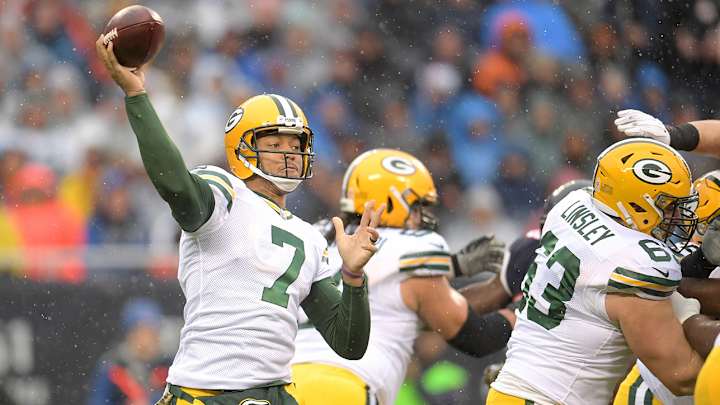Brett Hundley Finally Provides Hope

The second half of Green Bay’s game at Soldier Field brought something that has evaded the Packers since Aaron Rodgers broke his collarbone in Week 6: hope. After an uninspiring first half in which fill-in QB Brett Hundley continued to struggle with decision making, field vision and accuracy, the third-year quarterback connected on 10 of 13 passes for 126 yards and a touchdown—in wet conditions, against an underrated Bears defense, no less.
Highlighting that second half were two big-time completions to Davante Adams. The first was a 19-yard touchdown that came late in the down, a situation where Hundley, despite his mobility, had not previously thrived. When Hundley got outside the pocket, Adams, as the widest receiver is taught to do in Green Bay’s scramble drill, turned and took his route deep downfield, beating cornerback Kyle Fuller. Hundley, on the move, made a great front-pylon throw.
The second big Adams completion was a 42-yard Go ball on third-and-10 with 2:12 remaining. This came after a Packers timeout (and a delay of game that made the third-and-5 a third-and-10). Hundley was likely told he could take that chance downfield since an interception would essentially serve as a punt. Fuller, who struggled much of the day, had perfect coverage this time, but perfect coverage gets beat by a perfect throw, and that’s what Hundley’s throw was. Adams converted this by making a one-handed basket catch.

This second half was the first time Green Bay’s offense resembled its usual self since Hundley stepped in. Hundley’s first 13 quarters of action, dating back to the Minnesota game and through the first half of this one, were so full of conservative play-calls and checkdowns (including several with receivers left open downfield) that it was hard to pinpoint any sort of identity.
The QB-movement tactics that Mike McCarthy installed for Hundley, such as read-options and various bootlegs, never became a foundational piece to Green Bay’s post-Rodgers offense, in part because Hundley did not consistently shine here. Against Chicago, McCarthy went back to the wide-ranging tactical changeups that he has employed before. There were significant snaps of five-receiver sets—a great tactic against a Bears defense that, almost no matter what, goes with just three cornerbacks and two linebackers on passing downs. There were also significant snaps of two-back sets, with fullback Aaron Ripkowski on the field with third-string tailback Jamaal Williams (injuries had knocked Aaron Jones and Ty Montgomery out of the game). Over the years McCarthy has used two-back sets to stabilize his offense, especially in November and December. Expect the Packers to continue using this package, only with more passes built in. Hundley is still very green when it comes to reading coverages; a two-back set will provide a predictable defensive look.
When you go with a backup QB for a long stretch, your defense must also adjust. Against an underwhelming Bears offense, the Packers got aggressive with five-man blitzes (most of them right up the middle) and man coverage. They sacked Mitchell Trubisky five times to win the field position battle—something that’s more important with Rodgers out. Defensive coordinator Dom Capers loves to play this way but toggles in and out of aggressive play-calling each week, depending on the opponent.
Three of the Packers’ next four games are against the Ravens, Bucs and Browns, teams with downtrodden passing games. Expect to see more of the creative, attack-minded Capers, with the intent being to steal possessions and swing field position. That will be mandatory for helping Green Bay’s offense. After Hundley’s second half against the Bears, it’s an offense that once again has an identity (a watered-down version of its old one, but still) and a play-caller with newfound confidence in his QB. The playoffs are still a long shot, but for Hundley and the 5-4 Packers, they’re no longer a moonshot.
• Question or comment? Email us at talkback@themmqb.com.
